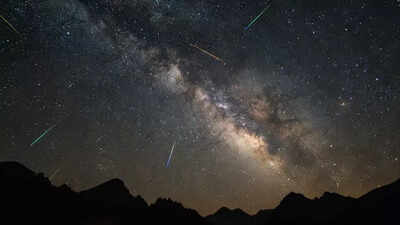Get ready to ditch the city lights and look up! The celestial event of the month, the Leonid meteor shower, is about to light up the sky, peaking on the night of November 16-17, 2025. These dazzling “shooting stars” are renowned as some of the fastest in the cosmos, created as Earth streaks through the dusty trail left by Comet 55P/Tempel-Tuttle. Because this year features excellent, moon-free conditions and the potential for up to 40 meteors per hour, now is your chance to witness the natural fireworks. Read on for your simple, step-by-step guide on the best time to look up, where to point your gaze, and how to maximize your viewing success.
What are the Leonids?
The origin of these meteors is the tiny, dusty trail left behind by Comet 55P/Tempel-Tuttle. As Earth orbits the Sun each November, it passes directly through this debris field. The specks of dust, most smaller than a grain of sand, vaporize upon atmospheric entry, creating the flash we observe from the ground. While typically producing a modest display, the Leonids are famously known for their meteor storms—intense periods where thousands of meteors can fall per hour, a spectacular event that occurs roughly every 33 years, coinciding with the comet’s orbital period. While 2025 is not a storm year, conditions promise excellent visibility.
When to watch?
Astro-observers predict the shower’s peak around 18:00 UTC on 17 November 2025, that converts to 21:00 (9:00 pm) on 17 November in Qatar (UTC+3). Even so, the best practical viewing is after midnight and into the pre-dawn hours, when the Leo radiant climbs higher and more of the sky is favourable. Expect about 10–15 meteors per hour under good, dark skies (some sources give up to ~15–20/hour as a generous peak estimate).
Where to look for Meteors?
The Leonid meteor shower is active annually from around November 6 until November 30, but the best viewing opportunity, the peak, occurs on the night between November 16 and 17, 2025. The absolute ideal time to watch is after midnight until the pre-dawn hours on the morning of November 17, when the meteor shower’s radiant point is highest in the sky.The meteors appear to originate from the constellation Leo the Lion (hence the name Leonids), which rises in the east/northeast after midnight. While they seem to stream from Leo, viewers are advised to look 30 to 40 degrees away from the radiant. Looking away from Leo allows you to catch the meteors streaking across a wider section of the sky, maximizing the chance of seeing longer, more dramatic trails.Globally, rates are expected to be around 10 to 15 meteors per hour (ZHR). However, local astronomical experts have suggested the rate could reach up to 40 meteors per hour in exceptionally dark viewing locations, providing the potential for a significantly better display.
Maximizing your meteor hunt
This year presents a particularly favorable chance to view the Leonids, primarily due to the state of the Moon.
- Moon-Free Skies: The shower peaks when the Moon is in its waning crescent phase, meaning it will be only about 9 percent illuminated. This minimal moonlight translates to significantly darker skies, preventing light pollution from the Moon itself from washing out the fainter meteors.
- Find the Dark: The most crucial tip for any meteor shower is to escape city lights. Find a secluded spot far away from all sources of light pollution (such as streetlights and residential areas). Your eyes need complete darkness to adjust fully.
- Go Naked-Eye: You do not need any special equipment like telescopes or binoculars; these tools are too zoomed-in to capture the sweeping path of a meteor. All you need are your naked eyes and patience.
- Allow Adjustment Time: Once you arrive at your dark location, allow your eyes a minimum of 20 to 30 minutes to fully adjust to the darkness. Any bright phone screen light will immediately reset this process.
- Get Comfortable: Bring a comfortable chair or blanket. Meteor viewing is a waiting game, so lie back with your feet pointing generally toward the east/northeast and scan the entire expanse of the sky.
As the Leonids sweep across Qatar’s sky on November 17, this is your once-a-year chance to slow down, look up, and enjoy a natural light show that needs nothing more than clear skies and a little patience. Whether you’re watching from the desert, the coastline, or your rooftop, the night promises a mix of calm, wonder, and those brief streaks of magic that remind us how alive the sky really is. Enjoy the moment, the Leonids are here, and they’re worth staying up for. Go to Source


